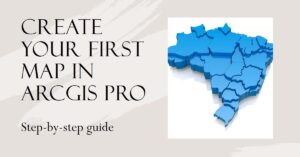Introduction to GIS datasets
GIS (Geographic Information System) datasets are collections of geospatial data that represent real-world objects’ properties, attributes, and relationships. These databases are critical in a variety of industries, including urban planning, environmental management, transportation, agriculture, and others. In this article, we will look at the top ten GIS datasets and how to use them efficiently.
Importance of GIS datasets
GIS files are important because they provide a plethora of information about the world around us. They provide useful insights on geographical patterns, linkages, and trends for academics, analysts, and decision-makers. Professionals may make informed judgments, manage resource allocation, and solve difficult spatial challenges by analyzing and displaying these datasets.
Criteria for selecting GIS datasets
Several criteria should be considered while selecting GIS datasets for a specific project or investigation. Data accuracy, resolution, coverage area, data format, license constraints, update frequency, and compatibility with the GIS program used are some of these. Choosing the correct datasets ensures that the results are reliable and meaningful.
Top 10 GIS datasets and their applications
- Population Density Data: Population density datasets describe the distribution of people in a given area. They are useful for urban planning, resource allocation, and social pattern analysis.
- Land Use and Land Cover Data: These datasets describe the different forms of land use and land cover that exist in a given location, such as residential, commercial, agricultural, or natural regions. They are critical for land management, environmental monitoring, and analyzing urban expansion.
- Transportation Network Datasets: This contain information on roads, highways, railroads, airports, and other transportation infrastructure. They are essential for route optimization, traffic analysis, and city transportation planning.
- Elevation Data: Elevation datasets describe the height or depth of the Earth’s surface. They’re utilized in terrain analysis, flood modeling, viewshed analysis, and 3D visualization, among other things.
- Climate and Weather Datasets: This contain information about temperature, precipitation, wind patterns, and other meteorological characteristics. They are useful for studying climate change, forecasting weather, and agricultural planning.
- Hydrological Databases: This include rivers, lakes, watersheds, and other water-related properties. They play an important role in water resource management, flood mapping, and hydrological modeling.
- Datasets for Vegetation: Datasets for vegetation represent the distribution and features of plant life in a given area. They are utilized in ecological studies, forest management, and the conservation of biodiversity.
- Geology Data: Geology datasets describe the composition, structure, and age of rocks and geological formations. Mineral exploration, geological hazard assessment, and geological mapping all rely on them.
- Satellite Imaging Datasets. These are made up of high-resolution photographs collected by satellites orbiting the Earth. They are commonly utilized in remote sensing, classification of land cover, disaster monitoring, and urban planning.
- Demographic Data: Demographic datasets include information regarding demographic variables such as age, gender, income, education level, and household size. They are useful for market research, social planning, and policy formulation.
How to access and use GIS datasets
GIS datasets can be accessed from a variety of sources. Many government agencies, research institutions, and commercial suppliers provide GIS datasets for free or for a fee. Online platforms and data repositories make it easy to access a wide variety of datasets. After obtaining the datasets, they can be loaded into GIS software like ArcGIS or QGIS for analysis, visualization, and integration with other spatial data.
Understanding the data structure, properties, and coordinate systems is required when working with GIS datasets. To extract significant insights, geographical analysis techniques such as buffering, overlay analysis, and spatial interpolation can be used. Visualizing data via maps, charts, and graphs improves comprehension and sharing of outcomes.
Case studies showcasing the use of GIS datasets
Case Study: Urban Planning – Population Density Analysis:
Utilizing population density datasets, urban planners can identify areas with high population concentrations, leading to informed decisions regarding infrastructure development, transportation networks, and social services.
Case Study: Environmental Management and Land Cover Change Detection:
Land use and land cover datasets enable environmental managers to monitor changes in vegetation, urban expansion, or deforestation over time. This information aids in developing conservation strategies and assessing the impact of land-use changes on ecosystems.
Case Study: Disaster Management – Flood Mapping:
By integrating elevation data with hydrological datasets, flood-prone areas can be identified, enabling proactive measures to mitigate the risk, plan evacuation routes, and develop emergency response strategies.
Challenges and limitations of GIS datasets
While GIS datasets offer immense value, they also come with certain challenges and limitations. These include:
- Data Accuracy: Due to constraints in data collection methods or old information, GIS datasets may contain errors or inaccuracies. When analyzing the results, it is critical to consider data quality and any biases.
- Data Availability: Due to privacy concerns, licensing limitations, or limited access, some datasets may be restricted. Researchers and analysts must be conscious of data availability and, if necessary, seek out alternate sources.
- Data Integration: Due to differences in data formats, coordinate systems, and attribute structures, integrating various datasets from different sources can be difficult. To assure interoperability, data pretreatment and standardization may be required.
- Technical Expertise: Utilizing GIS datasets effectively requires a certain level of technical expertise and familiarity with GIS software. Adequate training and proficiency in data analysis techniques are necessary for accurate interpretation and decision-making.
Future trends in GIS datasets
The field of GIS datasets continues to evolve rapidly, driven by advancements in technology and data acquisition methods. Some emerging trends include:
- Big Data and Machine Learning: The availability of enormous volumes of geographical data, along with the use of machine learning algorithms, allows for improved analysis and predictive modeling, resulting in more accurate and efficient decision-making.
- Real-Time Data: With the introduction of IoT (Internet of Things) devices and sensors, the collecting of real-time geographical data has become more common. This enables dynamic monitoring, response, and decision-making in a variety of sectors, including transportation, environmental monitoring, and smart city management.
- Governments and organizations around the world are increasingly embracing open data programs, making GIS databases more accessible to the public. Collaboration, innovation, and community-driven solutions are encouraged as a result.
Conclusion
GIS databases are significant resources that provide information about our surroundings. They are critical in decision-making, planning, and comprehending complex spatial relationships. Professionals across sectors may unlock the power of geospatial information and promote good change in their respective fields by leveraging the top ten GIS datasets highlighted in this article.
FAQs (Frequently Asked Questions)
- Q: Are GIS datasets only useful for professionals in technical fields?
No, GIS datasets have applications in various fields, including urban planning, environmental management, public health, business analysis, and more. They can benefit professionals from diverse backgrounds.
- Q: Can I create my own GIS datasets?
Yes, you can create your own GIS datasets by collecting data using GPS devices, conducting surveys, or digitizing existing maps. This allows you to tailor the data to your specific needs.
- Q: Are GIS datasets always accurate?
GIS datasets strive for accuracy, but they may contain errors or limitations. It’s important to consider data quality and potential biases when interpreting the results.
- Q: How often are GIS datasets updated?
The update frequency of GIS datasets varies depending on the data source. Some datasets may be updated regularly, while others may have longer intervals between updates. Always check the metadata for the latest information.
- Q: Are GIS datasets available for free?
Some GIS datasets are available for free, while others may require a subscription or purchase. Many government agencies and research institutions provide free access to certain datasets, but more specialized or detailed datasets may come at a cost.


